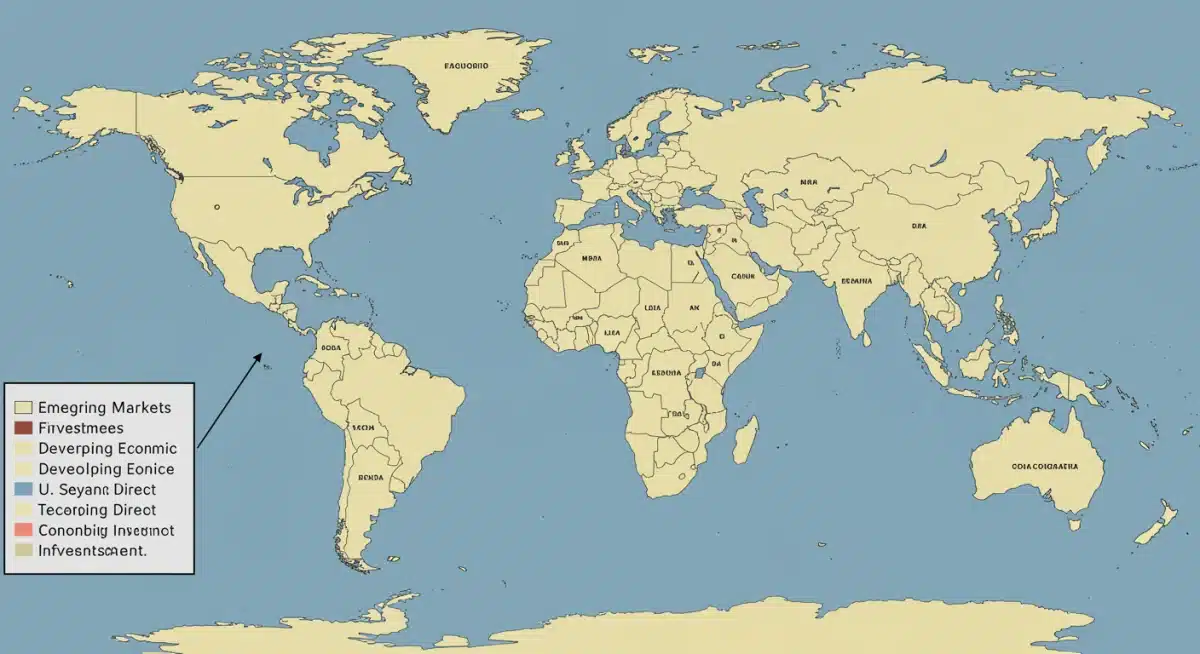World Bank 2025 Outlook: US Investment Repercussions

The World Bank’s 2025 economic outlook predicts significant shifts in global growth, directly impacting U.S. investments abroad through evolving market conditions, policy changes, and risk profiles across various regions.
The World Bank’s 2025 Economic Outlook: Key Repercussions for U.S. Investments Abroad presents a critical juncture for American businesses and investors. Understanding these projections is not merely an academic exercise; it’s a strategic imperative that could shape investment decisions, mitigate risks, and uncover new opportunities in an increasingly interconnected global economy.
Global Growth Projections and Their Ripple Effects
The World Bank’s 2025 economic outlook paints a nuanced picture of global growth, characterized by persistent challenges and pockets of resilience. Developed economies are expected to navigate a path of moderate expansion, while emerging markets and developing economies (EMDEs) will continue to be the primary drivers of global growth, albeit with varying degrees of success and stability. These broad trends have profound ripple effects for U.S. investors looking beyond domestic borders.
The overall pace of global economic activity directly influences demand for goods and services, commodity prices, and currency valuations, all of which are critical factors in the profitability and risk assessment of international investments. A slower global growth trajectory, for instance, might dampen export opportunities for U.S. companies operating abroad, while robust growth in specific regions could signal attractive new markets.
Differing Regional Growth Trajectories
The World Bank’s report highlights significant divergence in growth prospects across different regions. While some Asian economies are projected to maintain strong growth momentum, others in Sub-Saharan Africa or Latin America might face headwinds from debt vulnerabilities, political instability, or commodity price volatility. This regional disparity demands a highly granular approach from U.S. investors, moving beyond a one-size-fits-all strategy.
- Asia’s Enduring Momentum: Many Asian economies are expected to continue their growth, driven by domestic demand and technological advancements, presenting opportunities in sectors like technology, manufacturing, and consumer goods.
- Latin American Volatility: The region could experience uneven growth, influenced by political cycles, commodity dependence, and structural reforms, requiring careful risk assessment for U.S. investments.
- African Potential and Challenges: Sub-Saharan Africa offers long-term growth potential due to demographic trends and resource wealth, but also faces significant challenges related to governance, infrastructure, and climate change.
In conclusion, the global growth projections underscore the need for U.S. investors to adopt a selective and informed approach to international markets. Understanding the specific growth drivers and constraints of each region is paramount to identifying both opportunities and potential pitfalls, ensuring that investment strategies are aligned with the prevailing economic realities.
Inflationary Pressures and Interest Rate Environments
Persistent inflationary pressures and the resulting interest rate policies by central banks worldwide are central to the World Bank’s 2025 outlook. While inflation may moderate from recent peaks, it is unlikely to return to pre-pandemic levels in many economies, leading to a prolonged period of elevated interest rates. This environment significantly impacts the cost of capital, debt servicing, and overall profitability for U.S. businesses operating internationally.
Higher interest rates globally can make borrowing more expensive for foreign subsidiaries of U.S. companies, potentially stifling expansion plans or reducing returns on investment. Furthermore, a strong U.S. dollar, often a consequence of higher domestic interest rates, can make U.S. exports more expensive and reduce the value of repatriated foreign earnings when converted back to dollars.
Impact on Capital Flows and Currency Valuations
The interplay between inflation and interest rates directly influences global capital flows. Countries with higher real interest rates tend to attract foreign investment, potentially leading to currency appreciation. Conversely, economies grappling with persistent inflation and less aggressive monetary policy might see capital outflows and currency depreciation, posing risks for U.S. investors.
- Emerging Market Debt: Many EMDEs carry significant dollar-denominated debt, making them vulnerable to rising U.S. interest rates and a stronger dollar, increasing their debt servicing costs.
- Currency Risk Management: U.S. investors must prioritize robust currency risk management strategies, including hedging, to protect against adverse exchange rate movements that can erode investment returns.
- Sectoral Impact: Export-oriented sectors in countries with depreciating currencies might become more competitive, potentially offering new investment avenues, while import-dependent sectors could face increased costs.
Ultimately, the global inflationary and interest rate landscape demands that U.S. investors meticulously evaluate the financial health of their foreign ventures, monitor central bank policies, and integrate currency and interest rate risk into their investment models. Adapting to these evolving financial conditions will be crucial for maintaining profitability and stability in international portfolios.
Geopolitical Risks and Supply Chain Resilience
The World Bank’s 2025 outlook underscores the escalating significance of geopolitical risks and their profound implications for global supply chains. From regional conflicts to trade disputes and political instability, these factors introduce considerable uncertainty for U.S. investments abroad. The interconnectedness of the global economy means that disruptions in one region can quickly cascade, affecting production, logistics, and market access worldwide.
U.S. investors must increasingly factor geopolitical considerations into their decision-making processes, moving beyond purely economic metrics. Supply chain resilience has become a paramount concern, as businesses seek to diversify sourcing, localize production, and build redundancies to mitigate against future shocks. This strategic shift requires significant capital investment and a rethinking of traditional global operational models.

Diversification and Localization Strategies
In response to persistent geopolitical risks, many U.S. companies are re-evaluating their global footprints. This often involves strategies aimed at reducing reliance on single-source suppliers or overly concentrated production hubs. The push towards diversification and localization is not just about mitigating risk but also about adapting to evolving trade policies and national security priorities.
- Nearshoring/Friendshoring: Companies are increasingly considering relocating production closer to home (nearshoring) or to politically aligned countries (friendshoring) to enhance supply chain security.
- Technological Autonomy: Investments in domestic technological capabilities and R&D are growing, aiming to reduce dependence on foreign critical technologies and intellectual property.
- Risk Mapping and Scenario Planning: Robust geopolitical risk mapping and scenario planning are essential tools for U.S. investors to anticipate potential disruptions and develop contingency plans.
In summary, the heightened geopolitical risk environment necessitates a proactive and adaptive approach from U.S. investors. Building resilient supply chains and strategically diversifying investments are no longer optional but fundamental requirements for sustained success in the global arena. This implies a careful balance between efficiency and security, often leading to higher operational costs but greater stability.
Technological Transformation and Digitalization
The World Bank’s 2025 outlook highlights the accelerating pace of technological transformation and digitalization as a key driver of economic change and a major area for U.S. investments abroad. From artificial intelligence and blockchain to advanced manufacturing and renewable energy technologies, innovation is reshaping industries and creating new markets globally. U.S. companies are at the forefront of many of these advancements, positioning them well to capitalize on international opportunities.
Investing in digital infrastructure, R&D, and technology-driven startups in foreign markets can yield substantial returns, but also comes with unique challenges. These include navigating diverse regulatory environments, protecting intellectual property, and adapting products and services to local market needs. The digital divide, while narrowing, still presents barriers in some developing economies, requiring tailored investment approaches.
Key Investment Areas in Digitalization
The digitalization trend opens up a multitude of investment avenues for U.S. firms. These range from direct investments in tech companies to supporting the digital transformation of traditional industries. The demand for digital services, e-commerce platforms, and data infrastructure is booming across many EMDEs, driven by increasing internet penetration and smartphone adoption.
- Fintech Innovation: Investments in financial technology (fintech) in emerging markets can address financial inclusion gaps and capitalize on rapidly expanding digital payment ecosystems.
- AI and Automation: Deploying AI and automation solutions in foreign manufacturing or service industries can enhance efficiency and productivity, creating new competitive advantages.
- Green Technologies: As global climate change concerns grow, investments in renewable energy, smart grids, and sustainable agriculture technologies offer significant long-term potential.
To conclude, the technological transformation presents a fertile ground for U.S. investments abroad, offering significant growth potential for those willing to innovate and adapt. Success hinges on understanding local market dynamics, navigating regulatory complexities, and strategically leveraging U.S. technological leadership to create value in a digital-first global economy.
ESG Factors and Sustainable Investing
Environmental, Social, and Governance (ESG) factors are increasingly central to the World Bank’s 2025 economic outlook and are profoundly influencing U.S. investment decisions abroad. Investors are no longer solely focused on financial returns but are also scrutinizing the sustainability and ethical performance of their foreign ventures. This shift is driven by growing global awareness of climate change, social inequality, and corporate accountability, coupled with regulatory pressures and consumer demand.
For U.S. companies, integrating ESG considerations into international investment strategies is becoming a necessity, not just a choice. Failure to do so can lead to reputational damage, regulatory fines, and reduced access to capital. Conversely, strong ESG performance can enhance brand value, attract responsible investors, and foster long-term resilience in foreign markets.

Opportunities in Sustainable Development
The emphasis on ESG creates significant opportunities for U.S. investors to contribute to sustainable development while generating financial returns. Emerging markets, in particular, often present substantial needs for sustainable infrastructure, clean energy, and social programs, aligning with ESG investment mandates. Investing in these areas can also unlock access to international development finance and impact investing funds.
- Green Bonds and Sustainable Finance: Participation in the growing market for green bonds and other sustainable finance instruments can fund environmentally friendly projects abroad.
- Social Impact Investments: Investments in education, healthcare, and affordable housing in developing countries can address social needs while generating measurable returns.
- Improved Governance Standards: Promoting strong governance practices in foreign subsidiaries can mitigate corruption risks and enhance long-term operational stability and investor confidence.
In conclusion, the rising prominence of ESG factors means that U.S. investors must adopt a holistic approach to international investing, where financial performance is intertwined with environmental stewardship, social responsibility, and robust governance. This integration is not only ethically sound but increasingly critical for long-term financial success and market acceptance in the global investment landscape.
Policy Frameworks and Regulatory Changes
The World Bank’s 2025 economic outlook also emphasizes the dynamic nature of policy frameworks and regulatory changes across global economies, which directly impact U.S. investments abroad. Governments worldwide are continually adjusting their policies in response to economic shifts, technological advancements, and geopolitical pressures. These changes can range from new trade agreements and investment incentives to stricter environmental regulations and data privacy laws.
For U.S. investors, staying abreast of these evolving regulatory landscapes is crucial. A favorable policy environment can significantly reduce operational costs and risks, while an unpredictable or restrictive one can create substantial barriers. Understanding the nuances of foreign legal and regulatory systems is essential for compliance, market entry, and dispute resolution.
Navigating Diverse Regulatory Environments
The challenge for U.S. investors lies in the sheer diversity of regulatory environments. What is permissible in one country may be prohibited in another, requiring careful legal due diligence and localized adaptation of business practices. This complexity often necessitates engaging local legal and consulting expertise to ensure full compliance and to identify potential policy-driven opportunities or threats.
- Trade and Investment Pacts: Monitoring new trade agreements and bilateral investment treaties can reveal new market access opportunities or changes in investment protection.
- Taxation and Incentives: Understanding local tax regimes, including corporate taxes, withholding taxes, and available investment incentives, is vital for financial planning and maximizing returns.
- Data Privacy and Cybersecurity: Compliance with evolving data privacy laws (e.g., GDPR-like regulations) and cybersecurity requirements is critical for U.S. tech and data-driven investments abroad.
To summarize, the evolving policy and regulatory frameworks globally demand a proactive and informed approach from U.S. investors. Engaging with local experts, conducting thorough due diligence, and maintaining flexibility in operational strategies are key to successfully navigating these complexities and ensuring the long-term viability of international investments.
| Key Point | Brief Description |
|---|---|
| Global Growth Divergence | EMDEs drive growth, but regional disparities demand selective U.S. investment strategies. |
| Inflation & Interest Rates | Elevated rates impact capital costs and currency valuations, requiring robust risk management. |
| Geopolitical Risks | Increased instability necessitates supply chain diversification and localization efforts. |
| ESG & Technology | Sustainable investing and digitalization create new opportunities and compliance demands. |
Frequently Asked Questions About the World Bank’s 2025 Outlook
Global growth divergence means U.S. FDI will likely shift towards more resilient and rapidly expanding economies, particularly in parts of Asia. Investors will need to conduct more granular regional analysis, identifying specific sectors and countries with strong fundamentals while carefully avoiding areas prone to instability or slower growth. This requires a highly selective approach.
The primary currency risks for U.S. investors in 2025 stem from potential U.S. dollar strength due to higher interest rates, impacting the value of repatriated earnings. Additionally, volatility in emerging market currencies, driven by inflation or capital outflows, poses significant translation and transaction risks. Robust hedging strategies and careful monitoring of monetary policies are essential.
Mitigating geopolitical risks involves diversifying supply chains, potentially through nearshoring or friendshoring strategies, and localizing production. U.S. businesses should also implement comprehensive risk mapping, scenario planning, and maintain strong relationships with local stakeholders. Understanding regional political dynamics and regulatory environments is crucial for proactive risk management and operational continuity.
ESG factors are increasingly pivotal, influencing capital allocation and investor scrutiny. The World Bank’s outlook highlights that U.S. investors must integrate environmental, social, and governance considerations into their strategies to attract capital, enhance reputation, and ensure long-term sustainability. Investments aligned with sustainable development goals are expected to gain traction and offer new opportunities.
The most promising technological sectors for U.S. investments abroad include artificial intelligence, fintech, advanced manufacturing, and green technologies. These areas are experiencing rapid growth globally, particularly in emerging markets where digitalization and sustainable solutions are in high demand. U.S. leadership in innovation positions firms to capitalize on these transformative trends.
Conclusion
The World Bank’s 2025 economic outlook presents a complex yet navigable landscape for U.S. investments abroad. While global growth remains uneven, characterized by inflationary pressures, geopolitical uncertainties, and evolving policy frameworks, significant opportunities emerge from technological transformation and the increasing emphasis on ESG factors. U.S. investors who adopt a strategic, informed, and adaptable approach—prioritizing granular regional analysis, robust risk management, and a commitment to sustainable practices—will be best positioned to capitalize on these global shifts and ensure the long-term success of their international ventures.





